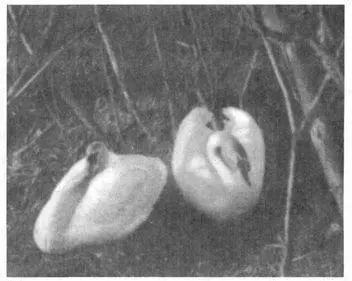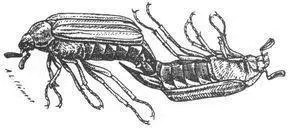The earliest photographic record of animal homosexuality: a pair of male Mute Swans photographed in 1923 on the nest they built together in Scotland. A female pair in the same species was first observed in 1885.

While most scientific studies of homosexuality in animals have simply involved careful and systematic observation and recording of behavioral patterns (occasionallysupplemented by photographic documentation), in some cases more elaborate measures have been employed. The study of animal behavior has now become extremely sophisticated and even “high-tech,” and many of these techniques have been applied with great effect to the recording, analysis, and interpretation of same-sex activities and their social context. DNA testing, for example, has been employed to ascertain the parentage of eggs belonging to lesbian pairs of Snow Geese, to determine the genetic relatedness of female Oystercatchers and Bonobos who engage in same-sex activity, to verify the sex of Roseate Terns (some of whom form homosexual pairs), and to investigate the genetic determinants of mating behavior in different categories of male Ruffs. The extent and characteristics of homosexual pair-bonding in Silver Gulls and Bottlenose Dolphins have been revealed by long-term demographic studies that identified and marked large numbers of individuals, who were then monitored over extended periods. Because most sexual activity in Red Foxes takes place at night, investigators only discovered same-sex mounting in this species by setting up infrared, remote-control video cameras that automatically recorded the animals’ nocturnal activities (night photography was also required to document similar activity in wild Spotted Hyenas). Radio tracking (biotelemetry) of individual Grizzlies revealed the activities of bonded female pairs, while similar techniques applied to Red Foxes yielded information about their dispersal patterns and overall social organization that relate to the occurrence of same-sex mounting. Videography, including “frame-by-frame” analysis of taped behavioral sequences, has been utilized in the study of courtship interactions in Griffon Vultures and Victoria’s Riflebirds, as well as of communicative interactions during Bonobo sexual encounters (both same-sex and opposite-sex). One ornithologist even x-rayed the eggs belonging to a homosexual pair of Black-winged Stilts to see if they were fertile (they weren’t). 7
A drawing from 1896 showing two male Scarab Beetles copulating with each other. This is one of the first scientific illustrations of animal homosexuality to be published.

Unfortunately, in a few cases scientists have subjected animals to more extreme experimental treatments, procedures, or “interventions.” During several studies of captive animals, same-sex partners in Rhesus Macaques, Bottlenose Dolphins, Cheetahs, Long-eared Hedgehogs, and Black-headed Gulls (among others) were forcibly separated, either because their activities were considered “unhealthy,” or in order to study their reaction and subsequent behavior on being reunited, or to try to coerce the animals to mate heterosexually. A female pair of Orange-fronted Parakeets was forcibly removed from their nest—which they had successfully defended against a heterosexual pair—in order to “allow” the opposite-sex pair to breed in their stead (based in part on the mistaken assumption that female pairs are unable to be parents). Female Stumptail Macaques had electrodes implanted in their uteri in order to monitor their orgasmic responses during homosexual encounters, while female Squirrel Monkeys were deafened to monitor the effect on vocalizations made during homosexual activities.
Although intended ostensibly to reveal important behavioral and developmental effects, the “treatments” applied to animals have in some cases been disturbingly similar to those administered to homosexual people in an attempt to “cure” them (separation or removal of partners, hormone therapy, castration, lobotomy, and electroshock, among others). Numerous primates, rodents, and hoofed mammals, for example, have been subjected to hormone injections to see how this might affect their homosexual behavior or intersexuality. Macaques were castrated as part of behavioral studies that included investigations of homosexual activity, as were White-tailed Deer to determine the “cause” of transgender in this species. Cats have even been lobotomized in order to study the effect on their (homo)sexuality. In some cases, biologists have gone so far as to kill individuals participating in same-sex activities (e.g., Common Garter Snakes, Hooded Warblers, Gentoo Penguins) in order to take samples of their internal reproductive organs. 8The reasons for this—usually to verify their sex or to determine the condition of their reproductive systems, including the presence of any “abnormalities”—reveal the incredulity as well as the often distorted preconceptions that many scientists harbor about homosexuality. As we will see in the next sections, these attitudes often carry over into the “interpretation” or “explanation” of homosexuality/transgender as well.
“A Lowering of Moral Standards Among Butterflies”: Homophobia in Zoology
…I have talked with several (anonymous at their request) primatologists who have told me that they have observed both male and female homosexual behavior during field studies. They seemed reluctant to publish their data, however, either because they feared homophobic reactions (“my colleagues might think that I am gay”) or because they lacked a framework for analysis (“I don’t know what it means”). If anthropologists and primatologists are to gain a complete understanding of primate sexuality, they must cease allowing the folk model (with its accompanying homophobia) to guide what they see and report.
—primatologist LINDA WOLFE, 1991 9
There is an astounding amount and variety of scientific information on animal homosexuality—yet most of it is inaccessible even to biologists, much less to the general public. What has managed to appear in print is often hidden away in obscure journals and unpublished dissertations, or buried even further under outdated value judgments and cryptic terminology. Most of this information, however, simply remains unpublished, the result of a general climate of ignorance, disinterest, and even fear and hostility surrounding discussion of homosexuality that exists to this day—not only in primatology (as Linda Wolfe describes), but throughout the field of zoology. Equally disconcerting, popular works on animals routinely omit any mention of homosexuality, even when the authors are clearly aware that such information is available in the original scientific material. As a result, most people don’t realize the full extent to which homosexuality permeates the natural world.
Scientists are human beings with human flaws, living in a particular culture at a particular time. Although the profession demands standards of “objectivity” and nonjudgmental attitudes, a survey of the history of science shows that this has not always been the case. For example, the sexism of much biological thinking has been exposed by a number of feminist biologists over the past two decades. 10They have shown that not only are scientists fallible human beings, but most are men—and their scientific theorizing has often been (and in many cases continues to be) detrimentally colored by their own and their culture’s (often negative) attitudes toward women. This observation can be taken a step further: scientists (who are often heterosexual) frequently project, consciously or unconsciously, society’s negative attitudes toward homosexuality onto their subject matter. As a result, both scientific and popular understanding of the subject have suffered. 11
Читать дальше














